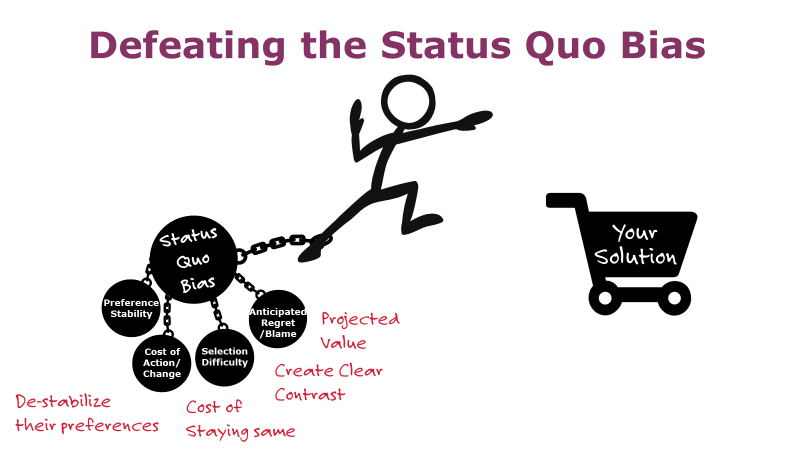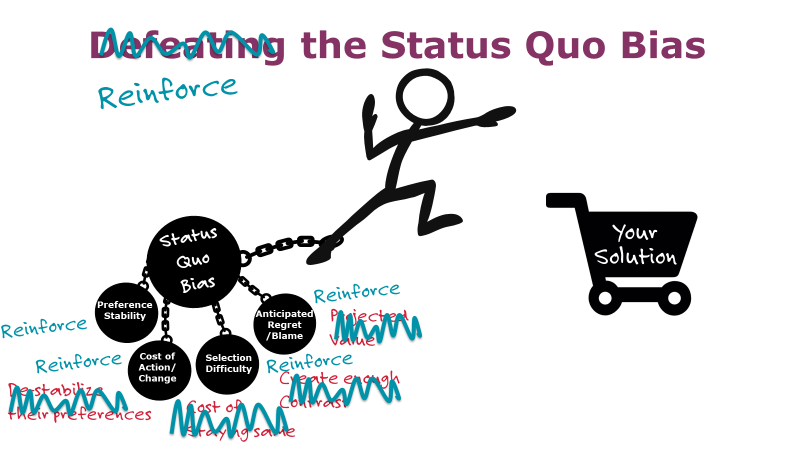Sales Mastery: Acquisition Is Not the Same as Expansion

Acquiring new business and expanding existing relationships are not the same selling process. A new skills training program presented by Tony Robbins applies decision making science to help you be more situationally relevant.
While challenging a prospect’s status quo bias may be essential when trying to displace an incumbent competitor, it can have the exact opposite effect in crucial conversations with existing customers.
In fact, research we have conducted with professors at the Stanford Graduate School of Business and Warwick Business School shows that you will decrease the likelihood of renewals, lower customer acceptance of price increases, and reduce your chances for an upsell if you use popular disruptive selling approaches.
Turns out, status quo bias is fundamentally critical knowledge for marketing and salespeople, because much of their success is predicated on either being able to help people see the need to change in customer acquisition or helping them see the need to stay in customer retention – and do more with you in customer expansion.
When the Status Quo Is Your Enemy
When you are the insurgent looking to steal some market share, your messaging and presentations must deliberately defeat these four causes of status quo bias:
- Preference stability – People prefer to keep their current preferences stable and will insist that your solution is a lot “like” what they are already doing. However, persuasion isn’t possible without uncertainty. So, your message must de-stabilize their current preferences by introducing “unconsidered needs”: problems or missed opportunities they didn’t even know they had.
- Perceived cost of change – Prospects believe the status quo is free, and that they will have to invest additional money, time, and stomach lining to bring in a new solution. People are two to three times more likely to make a change to avoid a certain loss with their current approach than to take the risk for potential gain using a new approach. This creates a high hurdle for your solution to overcome. As a result, your message must clearly show them the cost of staying the same.
- Selection difficulty – Everyone is overwhelmed with the amount of information available on any given solution. The part of the brain that makes the decision to change relies on clear contrast between what you are proposing and what they are doing, as well as competing alternatives. Value lives in contrast: no contrast, no value. Show them enough contrast to help them see the value in change.
- Anticipated regret – Someone suffering from status quo bias is a denier. They are in denial that they have a problem that needs to be solved, and they worry about getting the blame if they change something that wasn’t broken. The best antidote is for you to share a proof story of someone just like them who didn’t think they had a problem, but discovered they did – and successfully implemented your solution with great results. The key is telling both the before and after parts of the success story.

When the Status Quo Is Your Friend
When you are the incumbent looking to keep your best customers, get them to pay more, and sell them add-ons, you must deliberately defend these four causes:
- Reinforce preference stability – Document the results and impact you’ve had to date and remind them of the level of diligence they put in place to decide on you in the first place. Refresh decision makers on why they chose you – and transfer ownership of the decision to any new deciders.
- Reinforce perceived cost of change – Highlight the investments that have been made in putting your solution in place, including onboarding and training their teams, updating and changing their processes, and any one-time investments that are now sunk costs. No one wants to do that again.
- Reinforce selection difficulty – Showcase how you have made sure your solution has kept pace with the market. Remember: People don’t change if they don’t see enough contrast. So, counter-intuitively, it may serve you best to show how your solutions are keeping pace with anything they are hearing or reading about in the market.
- Reinforce anticipated regret – No one wants to stop positive momentum, so share the progress you’ve made – from where they started to where they are now. You want to show their risk of losing ground that has been gained if they make a change at this stage of their journey. Sharing an example of another company who changed and came back could help here.

New Science-backed Sales Skills Training Presented by Tony Robbins
The ability to articulate value and be situationally relevant is what separates successful sales teams from those who don’t hit their growth targets. Recently, Tony Robbins (the world’s leading personal and business development coach) partnered with Corporate Visions (the top sales story and skills training company) to offer a new science-backed sales skills program.
Corporate Visions Sales Mastery™, presented by Tony Robbins, is a comprehensive value selling skills program rooted in human decision-making psychology that helps you master the invisible forces that shape choices. Knowing how to defeat (or defend) status quo bias is just one of more than 30 concepts offered in this online training, practice, and coaching system available at www.cvsalesmastery.com.
“My goal was to provide a way for anyone who needs to up their game in the area of sales and customer conversations to have access to the kind of training that is typically reserved for the most professional sales forces at the biggest enterprises,” said Tony Robbins.
“We’re packaging it and pricing it in a way that brings these powerful concepts to a much wider audience who will benefit immediately from more pipeline, more closed deals, and more profitable customers.”
Tim Riesterer is the Chief Strategy Officer at Corporate Visions.
Get our Enewsletter
Get the latest sales leadership insight, strategies, and best practices delivered weekly to your inbox.
Sign up NOW →